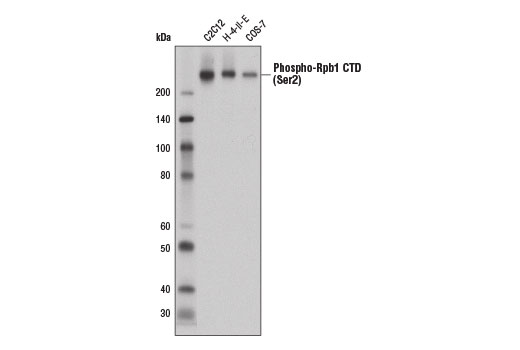

 下载产品说明书
下载产品说明书 下载SDS
下载SDS 用小程序,查商品更便捷
用小程序,查商品更便捷



 收藏
收藏
 对比
对比 咨询
咨询



Product Usage Information
For optimal ChIP and ChIP-seq results, use 10 μl of antibody and 10 μg of chromatin (approximately 4 x 106 cells) per IP. This antibody has been validated using SimpleChIP® Enzymatic Chromatin IP Kits.The CUT&RUN dilution was determined using CUT&RUN Assay Kit #86652. The CUT&Tag dilution was determined using 100,000 cells in a total reaction volume of 100 μl.
| Application | Dilution |
|---|---|
| Western Blotting | 1:1000 |
| Immunoprecipitation | 1:50 |
| Chromatin IP | 1:50 |
| Chromatin IP-seq | 1:50 |
| CUT&RUN | 1:50 |
| CUT&Tag | 1:50 |






Specificity/Sensitivity
Species Reactivity:
Human, Mouse, Rat, Monkey






参考图片
Chromatin immunoprecipitations were performed with cross-linked chromatin from 4 x 106 HeLa cells and either 10 μl of Phospho-Rpb1 CTD (Ser2) (E1Z3G) Rabbit mAb or 2 μl of Normal Rabbit IgG #2729 using SimpleChIP® Enzymatic Chromatin IP Kit (Magnetic Beads) #9003. The enriched DNA was quantified by real-time PCR using SimpleChIP® Human β-Actin Promoter Primers #13653, human β-Actin intron 1 primers, SimpleChIP® Human β-Actin 3' UTR Primers #13669, and SimpleChIP® Human α Satellite Repeat Primers #4486. The amount of immunoprecipitated DNA in each sample is represented as signal relative to the total amount of input chromatin, which is equivalent to one.
Immunoprecipitation of Rpb1 from HeLa cell extracts using Rabbit (DA1E) mAb IgG XP® Isotype Control #3900 (lane 2) or Phospho-Rpb1 CTD (Ser2) (E1Z3G) Rabbit mAb (lane 3). Lane 1 is 10% input. Western blot analysis was performed using Phospho-Rpb1 CTD (Ser2) (E1Z3G) Rabbit mAb.
Western blot analysis of extracts from C2C12, H-4-II-E, and COS-7 cells using Phospho-Rpb1 CTD (Ser2) (E1Z3G) Rabbit mAb.
Peptide dot blot analysis demonstrating Phospho-Rpb1 CTD (Ser2) (E1Z3G) Rabbit mAb antibody specificity. Antibody binding to pre-coated Rpb1 CTD peptides is shown using Phospho-Rpb1 CTD (Ser2) (E1Z3G) Rabbit mAb, Phospho-Rpb1 CTD (Ser5) (D9N5I) Rabbit mAb #13523, a phospho-Rpb1 CTD (Ser7) antibody, and Phospho-Rpb1 CTD (Ser2/Ser5) (D1G3K) Rabbit mAb #13546. As expected, the Phospho-Rpb1 CTD (Ser2) (E1Z3G) Rabbit mAb only binds to phospho-Rpb1 CTD peptide when phosphorylated at Ser2.







 危险品化学品经营许可证(不带存储) 许可证编号:沪(杨)应急管危经许[2022]202944(QY)
危险品化学品经营许可证(不带存储) 许可证编号:沪(杨)应急管危经许[2022]202944(QY)  营业执照(三证合一)
营业执照(三证合一)